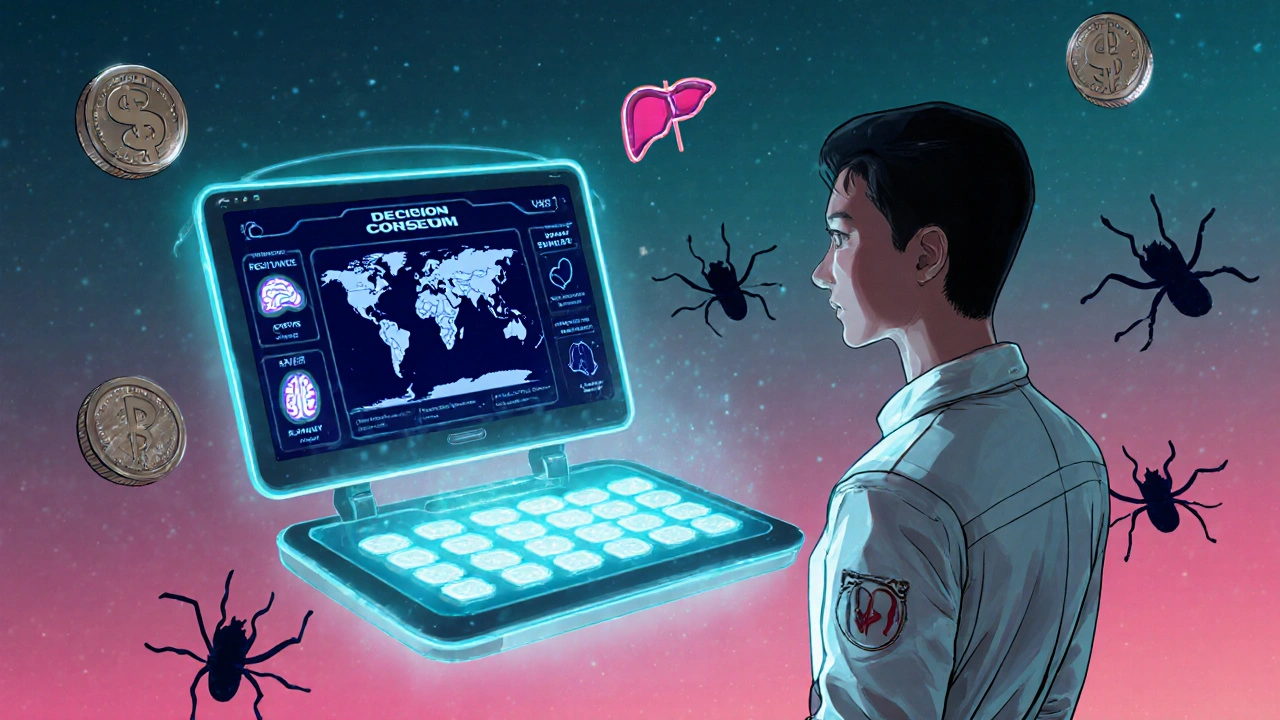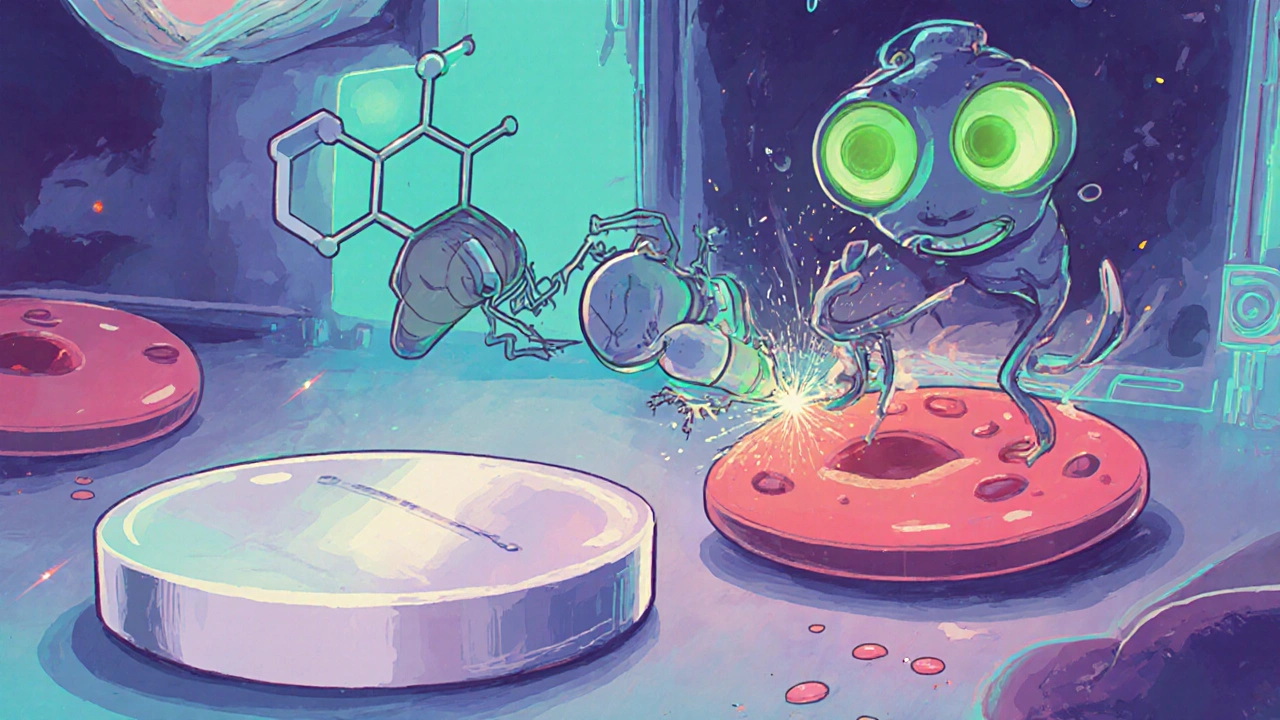Malaria Treatment Decision Tool
Treatment Selection Parameters
Treatment Recommendations
| Treatment | Efficacy | Cost | Key Considerations |
|---|
When treating malaria, Chloroquine is a synthetic 4‑aminoquinoline that interferes with the parasite’s heme detoxification process. Chloroquine has been a cornerstone of malaria therapy for decades, but growing resistance and safety concerns have prompted clinicians to consider other options. This guide walks you through the most common alternatives, comparing how they work, how safe they are, and what it costs to use them.
What Is Chloroquine?
First introduced in the 1930s, Chloroquine quickly became the go‑to drug for uncomplicated Malaria. It is taken orally, usually in a 25 mg/kg total dose over three days for adults. The drug accumulates in the parasite’s food vacuole, preventing the conversion of toxic heme into harmless hemozoin. While it works spectacularly against P. vivax and P. malariae, the rise of P. falciparum resistance in large parts of Africa and Southeast Asia has limited its utility.
Key Alternatives Overview
Below are the five alternatives most frequently considered when Chloroquine is unsuitable.
- Hydroxychloroquine - a less toxic derivative of Chloroquine, originally developed for rheumatoid arthritis and now used in some malaria protocols.
- Mefloquine - a quinoline‑methanol with a long half‑life, effective against many Chloroquine‑resistant strains.
- Doxycycline - a tetracycline antibiotic that blocks protein synthesis in the parasite.
- Artemisinin - a sesquiterpene lactone derived from the sweet wormwood plant, forming the backbone of modern combination therapies.
- Primaquine - a radical cure for liver-stage parasites, often paired with other agents.
How They Compare: Efficacy Against Malaria Species
Effectiveness varies by species and resistance patterns. The table below condenses data from the World Health Organization (2023) and recent peer‑reviewed trials.
| Drug | P. falciparum | P. vivax | P. malariae | P. ovale |
|---|---|---|---|---|
| Chloroquine | 45‑60 (high resistance zones) | 95‑99 | 98 | 94 |
| Hydroxychloroquine | 55‑70 (moderate resistance) | 96‑99 | 97 | 93 |
| Mefloquine | 90‑95 | 88‑92 | 90 | 87 |
| Doxycycline | 88‑93 | 85‑90 | 86 | 84 |
| Artemisinin‑based combo | 98‑100 | 97‑99 | 98 | 96 |

Safety Profile Comparison
Safety often drives the choice more than efficacy. Below is a quick rundown of the most frequent adverse events and serious concerns.
- Chloroquine: retinopathy (rare but dose‑dependent), cardiac arrhythmias, gastrointestinal upset.
- Hydroxychloroquine: similar to Chloroquine but lower risk of retinal toxicity; widely tolerated in rheumatology.
- Mefloquine: neuropsychiatric effects (vivid dreams, anxiety, rare seizures), contraindicated in patients with prior psychiatric illness.
- Doxycycline: photosensitivity, esophageal irritation, contraindicated in pregnancy and young children.
- Artemisinin: generally well‑tolerated; occasional nausea, dizziness; rare hepatic enzyme elevation.
- Primaquine: hemolysis in G6PD‑deficient individuals; requires screening before use.
Regulatory bodies such as the U.S. Food and Drug Administration (FDA) have issued specific warnings for Mefloquine’s neuropsychiatric risks, while the WHO recommends routine G6PD testing before Primaquine administration.
Dosage & Administration Differences
Understanding dosing helps avoid treatment failures.
- Chloroquine: 25 mg/kg total dose (e.g., 1 g followed by 500 mg at 6 h, 24 h, and 48 h).
- Hydroxychloroquine: 400 mg on day 1, then 200 mg twice daily for 2 days (total 1.2 g).
- Mefloquine: 15 mg/kg single dose (often 750 mg for adults), taken with food to reduce GI upset.
- Doxycycline: 100 mg twice daily for 7 days (or 200 mg once daily for 3 days).
- Artemisinin‑based combo (e.g., Artemether‑lumefantrine): six doses over three days, each dose containing 20 mg artemether/120 mg lumefantrine.
- Primaquine: 0.25 mg/kg daily for 14 days (radical cure), with higher doses for P. vivax in some regions.
Cost and Accessibility
Cost can be a deciding factor, especially in low‑resource settings.
- Chloroquine: inexpensive generic; $0.02-$0.05 per tablet in bulk.
- Hydroxychloroquine: modestly higher due to FDA‑approved rheumatology formulations; $0.10-$0.15 per tablet.
- Mefloquine: mid‑range; $0.30-$0.50 per tablet.
- Doxycycline: low‑cost generic; $0.05-$0.08 per tablet.
- Artemisinin combos: variable; $1.00-$3.00 per treatment course, often subsidized by malaria programs.
- Primaquine: cheap generic; $0.02-$0.04 per tablet, but requires G6PD testing infrastructure.
International donors and the WHO’s Global Malaria Programme frequently provide Artemisinin‑based therapy free of charge in endemic countries, whereas Chloroquine remains a staple in private pharmacies where resistance is low.

Choosing the Right Option: Decision Guide
Here’s a quick cheat‑sheet to help you match patient profiles with the best drug.
- Low‑resistance region, no contraindications: Chloroquine - cheap, simple dosing.
- Pregnant women or children < 5 years: Artemisinin combo (safe in 2nd/3rd trimester) or Doxycycline avoided.
- History of psychiatric illness: Avoid Mefloquine; consider Hydroxychloroquine or Artemisinin.
- G6PD deficiency known: Skip Primaquine; use Artemisinin combo or Doxycycline.
- Need for single‑dose therapy (e.g., travelers): Mefloquine or Artemisinin combo.
- Long‑term prophylaxis for travelers: Mefloquine weekly or Doxycycline daily, depending on tolerance.
Always cross‑check local resistance maps published by the WHO and national malaria control programs before finalising treatment.
Quick Comparison Chart
| Drug | GI Upset | Neuropsychiatric | Retinal Toxicity | Hemolysis (G6PD) |
|---|---|---|---|---|
| Chloroquine | Common | Rare | Rare (high dose) | None |
| Hydroxychloroquine | Common | Rare | Very rare | None |
| Mefloquine | Occasional | Common | None | None |
| Doxycycline | Common | None | None | None |
| Artemisinin combo | Occasional | None | None | None |
| Primaquine | None | None | None | High (if G6PD‑deficient) |
Bottom Line
Chloroquine remains a solid choice where resistance is low and cost is critical. However, in most endemic regions today, alternatives like Artemisinin‑based combination therapy (ACT) provide superior cure rates and a better safety margin. For travelers needing a single‑dose preventive, Mefloquine still shines-provided they have no psychiatric history. Always tailor the regimen to the patient’s health status, local resistance data, and budget constraints.
Is Chloroquine still recommended for malaria prophylaxis?
Only in areas where the parasite remains fully sensitive. Most African and parts of Southeast Asia have high resistance, so health agencies now favor Mefloquine, Doxycycline, or ACT for prophylaxis.
Can I use Hydroxychloroquine instead of Chloroquine for COVID‑19?
Clinical trials have not shown a clear benefit, and major health authorities (FDA, WHO) do not recommend it for COVID‑19 outside study protocols.
What is the biggest safety concern with Mefloquine?
Neuropsychiatric effects, ranging from vivid dreams to anxiety and, in rare cases, psychosis. Patients with a prior psychiatric history should avoid it.
How do I know if I need Primaquine after malaria treatment?
If you were infected with P. vivax or P. ovale, Primaquine is required to eradicate dormant liver forms (hypnozoites). A G6PD test is mandatory before starting.
Which antimalarial offers the best cost‑effectiveness in low‑income settings?
Artemisinin‑based combination therapies, despite a higher per‑dose price, are the most cost‑effective because they achieve near‑perfect cure rates and reduce the need for retreatment.


prithi mallick
October 23, 2025 AT 19:53Chloroquine still has a place where resistnce is low.
Michaela Dixon
October 23, 2025 AT 20:01Reading through the efficacy table feels like opening a vivid tapestry of data that sings of triumphs and setbacks alike the sheer variety of cure rates across species paints a picture of adaptive evolution in the parasite and the relentless ingenuity of medicinal chemistry that brings us hydroxychloroquine as a gentler sibling to chloroquine and mefloquine that stands tall with its long half‑life but hides a shadow of neuropsychiatric whispers doxycycline arrives as a trusty old antibiotic turning the parasite’s protein factories off like a dimmer switch while artemisinin bursts onto the scene like a lightning strike harvested from humble wormwood roots offering near‑perfect cure rates and a safety profile that gleams in the sun itself primaquine steps in as the silent guardian of liver stages reminding us that genetics matter because without G6PD testing it can turn lethal the cost ladder climbs from pennies for chloroquine to a few dollars for ACT yet the long‑term savings of cure outweigh the upfront price the dosing schedules dance from single‑day hits with mefloquine to multi‑day regimens with artemisinin combos the safety charts whisper of retinal risk with chloroquine and hydroxychloroquine photosensitivity with doxycycline and neuropsychiatric storms with mefloquine each choice a balance of geography patient profile and budget the WHO maps guide us like a compass pointing away from high‑resistance zones toward ACT in most endemic regions the traveler’s notebook notes that single‑dose mefloquine shines if you have no psychiatric history while pregnant women find solace in artemisinin combos the bottom line emerges clearly: no one drug fits all and clinicians must read the local resistance maps and weigh the side‑effect tapestry before prescribing.
Dan Danuts
October 23, 2025 AT 20:10Great rundown! I love how you laid out the safety profiles side by side – makes it easy to pick the right drug for the right patient. The friendly tone really helps even newbies understand the trade‑offs.
Dante Russello
October 23, 2025 AT 20:20Thanks for the comprehensive guide, the tables are incredibly useful, and the breakdown of side‑effects really helps clinicians make informed choices, especially in mixed‑resistance settings; the dosage details are spot‑on, and the cost comparison adds a practical layer, great work!
Celeste Flynn
October 23, 2025 AT 20:30The cost section is spot on; in many low‑income areas, the cheap price of chloroquine can be a deciding factor even if resistance is moderate. Also, remember that ACT programs are often subsidised, which can offset the higher per‑dose price.
Heather ehlschide
October 23, 2025 AT 20:40Good summary. I’d add that G6PD testing before primaquine is essential to avoid hemolysis.
Kajal Gupta
October 23, 2025 AT 20:50Yo, this post is fire! The way you compared the drugs is both formal enough for the docs and chill enough for us non‑experts. Keep it up!
Zachary Blackwell
October 23, 2025 AT 21:00Honestly, these official guidelines are just a smokescreen, you know? They don’t tell you about the hidden pharma agendas pushing ACT while keeping cheap chloroquine on the shelves for profit.
Danielle St. Marie
October 23, 2025 AT 21:10Interesting take, but the data speaks for itself 🧠✅. The safety record of ACT is solid, and the WHO backing isn’t some conspiracy – it’s evidence‑based. 👍
keerthi yeligay
October 23, 2025 AT 21:20Nice points, Dan. Just remember G6PD checks before primaquine.
Peter Richmond
October 23, 2025 AT 21:30While the long‑winded description is thorough, a concise summary for frontline workers would be beneficial.
Bonnie Lin
October 23, 2025 AT 21:40In short: use ACT where resistance is high; use chloroquine where it works.
Vikas Kumar
October 23, 2025 AT 21:50All this talk about cheap drugs is naive; we need strong national policies to protect our people from foreign pharma exploits.